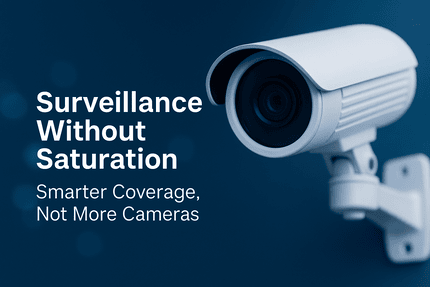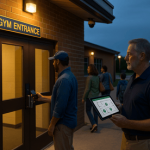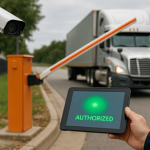
Transit facilities, fleet depots, and logistics hubs all face a common challenge: the need for visibility without creating camera chaos. While it may be tempting to install more and more surveillance cameras to ensure full coverage, more isn’t always better. In fact, oversaturating your facility with cameras can lead to operational blind spots, bandwidth strain, and decision fatigue.
What transit security leaders really need is strategic, intelligent surveillance—not just more hardware.
At SSP, we help organizations shift from "coverage quantity" to coverage quality, using smart technology and thoughtful placement to secure assets, protect passengers, and reduce risk—without turning control rooms into cluttered command centers.
k
k
🎥 The Problem with Too Many Cameras
Installing dozens or even hundreds of cameras in a facility might feel like the right approach—but it comes with hidden downsides:
🚫 Oversaturation Dilutes Effectiveness
Security teams can only monitor so many feeds at once. When camera walls are overwhelmed, important incidents are more likely to be missed.
💰 More Cameras = More Cost
Cameras aren’t just a one-time expense. They require network bandwidth, storage, maintenance, and software licenses. Overspending on cameras can divert budget away from analytics, training, or emergency systems.
⚠️ Redundancy Doesn’t Equal Coverage
Placing five cameras in the same zone may feel safer, but it often leads to redundant footage while leaving other critical areas exposed—like back gates, stairwells, or vehicle entry lanes.
k
k
✅ What “Smarter Coverage” Really Means
At SSP, we help transit and logistics clients rethink surveillance by focusing on:
1. Strategic Camera Placement
We start with a threat and operations assessment—what areas matter most? Rather than blanketing a site with cameras, we focus on:
-
Choke points (e.g., entrances, corridors, gates)
-
High-risk zones (e.g., storage, fuel depots, ticket machines)
-
Movement transitions (e.g., where foot traffic becomes vehicle traffic)
By mapping people, vehicle, and cargo flows, we position fewer cameras for maximum visibility and evidence quality.
k
k
2. Intelligent Video Analytics
Smart surveillance uses software to augment human awareness. Instead of watching passive feeds, AI-enabled cameras can detect:
-
Loitering or suspicious behavior
-
Unattended baggage or objects
-
Unauthorized access to restricted areas
-
Movement after hours or outside of designated zones
This allows teams to respond to alerts instead of endlessly watching video feeds—and reduces the need for redundant camera angles.
k
k
3. Integrated Coverage with Access Control
Video surveillance becomes far more powerful when tied to access events. When someone badges into a restricted zone, video is automatically bookmarked. If an unauthorized access attempt occurs, security is notified in real-time, with the video footage already queued.
This cuts investigation time and replaces camera oversaturation with actionable intelligence.
k
k
4. Remote and Mobile Viewing
Modern systems allow security managers to access cameras via secure apps, web platforms, or control room dashboards. With smart prioritization and alerts, teams can monitor multiple facilities without watching every single camera feed in real time.
Less hardware. More control.
k
k
🛠️ A Real-World Example
One SSP client—a mid-sized regional transit agency—originally had over 180 cameras spread across 4 bus depots. But despite the volume, they experienced:
-
Missed after-hours intrusions
-
Delayed responses due to video overload
-
Storage issues and camera downtime
SSP restructured their system, reducing camera count by 28%, while increasing coverage with:
-
Panoramic wide-angle cameras
-
Advanced motion-based analytics
-
LPR (license plate recognition) at vehicle gates
-
Smart tie-ins to access control and emergency call boxes
The result? Fewer incidents missed, faster response times, and lower total cost of ownership.
k
k
🚀 The Future: Smarter Surveillance, Not More Surveillance
The next wave of transportation facility security will be powered by:
-
Fewer, smarter cameras
-
Context-aware analytics
-
Unified security dashboards
-
Scalable storage with edge computing
-
Centralized alerts with decentralized monitoring
It’s not about covering every inch of a terminal or yard—it’s about covering the right inches.
k
k
🎯 Final Thought: Do More With Less
You don’t need more cameras. You need the right cameras, in the right places, supported by the right intelligence.
At SSP, we design camera systems that work harder—not just wider. From transit platforms to fleet depots and warehouse yards, we’ll help you build smarter surveillance that strengthens operations without overwhelming your team.
👉 Discover how SSP keeps transportation systems secure and operational. Contact us today to schedule a facility security audit.


